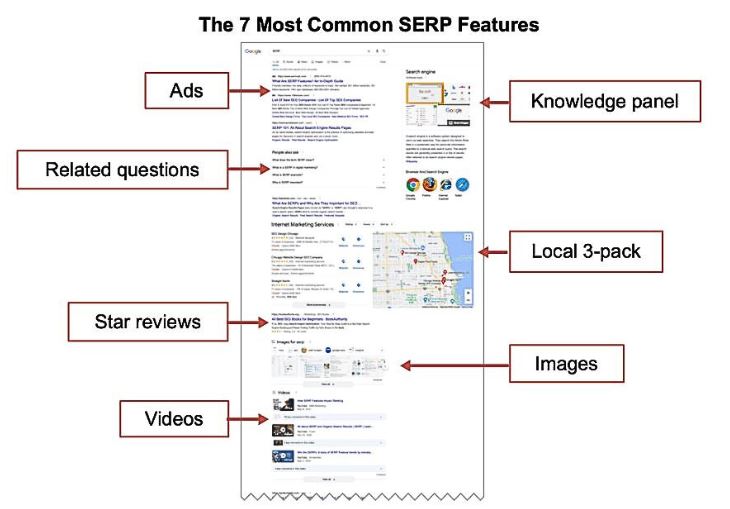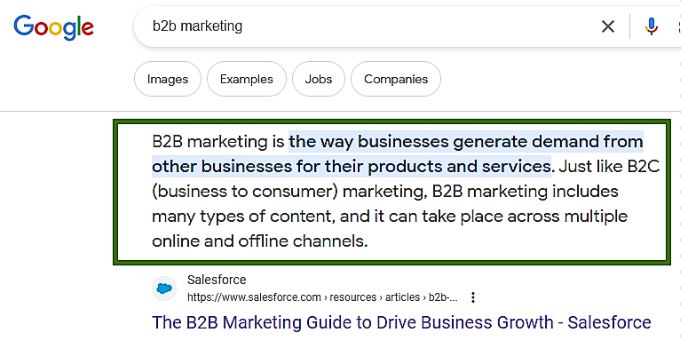Beyond the Traditional: Embracing the Whole-SERP SEO Approach
The Evolving Landscape of B2B SERPs in 2023: More than Just Blue Links
In an era characterized by swift technological evolution, the importance of Search Engine Results Pages (SERPs) has soared, transforming them into the cornerstone upon which B2B entities build their digital strategies. The relentless pace of innovation has brought us to 2023, where the early days of SERPs, dominated by basic blue hyperlinks, now seem archaic. These pages have matured, presenting a vast amount of opportunities, evolving into a dynamic and diverse playground that beckons digital marketers to dive in, experiment, and capitalize on.
This shift signifies a broader trend in the digital space, emphasizing the need for adaptability, innovation, and a deep understanding of the changing user expectations. With this evolution, the role of digital marketers is not just to keep up, but to anticipate and shape the future trends.
A Dynamic SERP Ecosystem
The SERPs of today are no longer linear lists. They are dynamic landscapes bursting with varied content forms, aiming to quench the diverse informational thirst of the users. Advanced AI-driven algorithms paired with Google’s ever-deepening grasp of user intent have resulted in SERPs that are carefully tailored mosaic masterpieces, aiming to provide the most relevant and precise answers to user queries.
These pages now cater to a wide spectrum of user needs, from quick facts to in-depth insights, ensuring a richer browsing experience. As users become more sophisticated in their search habits, the SERPs adapt and evolve, integrating multimedia content, direct answers, and interactive elements. It’s not just about ranking anymore; it’s about understanding and matching the multifaceted intent behind every search.

The Rise of Multimedia Content
Videos:
The digital realm has seen an unprecedented surge in video content. Recognizing the essence of videos in delivering succinct and detailed explanations, Google frequently places video content at the forefront for numerous B2B queries. From intricate product demonstrations and insightful webinars to user-friendly how-to guides, videos offer a multifaceted medium to cater to diverse B2B requirements.
Images:
Visual representations such as infographics, product snapshots, and graphical tutorials are increasingly taking center stage in B2B SERPs. These visuals distill complicated information into digestible formats, offering users a quick glance into the subject. This ascent of images in SERPs solidifies the age-old wisdom: “a picture is indeed worth a thousand words.”
Podcasts:
An audio-first approach has garnered traction with the rise of podcasts. B2B businesses are leveraging podcasts to discuss industry trends, share insights, and establish thought leadership. Recognizing this, some SERPs now feature relevant podcast episodes, enabling users to tap into expert conversations on-the-go. It underscores the need for businesses to think beyond traditional content formats and embrace evolving multimedia avenues.
Images:
The digital world is visually driven, and this has ushered in the dominance of image-based content in SERPs. Whether it’s an intricate infographic elucidating a complex process or a visually appealing product snapshot highlighting key features, images serve as an immediate touchpoint for users. They break down intricate topics, offering a visual aid that can enhance comprehension. Moreover, with the evolution of visual search capabilities, having high-quality and relevant images has become paramount for B2B entities. It’s not just about aesthetic appeal; it’s about conveying critical business information in a format that’s both accessible and engaging.
Interactive Graphics:
Beyond static images, interactive graphics have started to make their mark. These are visuals that users can engage with, such as clickable flowcharts or interactive diagrams that break down complex B2B processes. They not only provide information but also offer a hands-on experience, which can be particularly beneficial for topics that demand a deeper level of engagement and understanding. With the integration of these graphics, SERPs are evolving from passive information sources to interactive learning platforms.
Directories, Reviews, and Social Proof:
The digital revolution has amplified the significance of peer reviews and third-party evaluations. For B2B companies, directories serve as a centralized hub, often showcasing a business’s offerings, credentials, and accolades. It’s akin to a digital storefront, making it crucial for businesses to ensure accurate and flattering representation. Reviews, on the other hand, are the digital word-of-mouth. A slew of positive reviews can be the endorsement a potential client needs to make a decision, while negative ones can be a deterrent. Given that these reviews are now directly visible on SERPs, they play a pivotal role in shaping a brand’s reputation.
Rich Snippets and Interactive Features
Featured Snippets:
These bite-sized information chunks serve as Google’s way of offering users a preview of what they can expect from a linked page. Think of them as the trailer to a movie; if they’re engaging and relevant, users are more likely to dive deeper. Moreover, due to their highlighted position atop search results, they offer websites an opportunity for increased visibility, often referred to as “position zero.” For businesses, securing a featured snippet can lead to a significant spike in organic traffic, especially when the content directly addresses commonly asked questions in the industry.

Interactive Elements:
Modern-day SERPs aren’t just about static information. Google’s integration of interactive elements signifies its dedication to evolving user experiences. These elements can sometimes bypass the traditional click, offering tools and answers right within the search page. For instance, a B2B business in the finance sector might find its loan calculator feature embedded directly into SERPs. This calls for businesses to remain updated with the latest SERP trends and continuously refine their website’s structured data to align with Google’s evolving features.
The Importance of Adaptive SEO
Adaptive SEO isn’t just a buzzword; it’s the lifeblood of modern digital marketing. As SERPs become increasingly dynamic, businesses that stick to old-school SEO methodologies risk being overshadowed. It’s akin to navigating ever-shifting sands; what worked yesterday might be obsolete today. For B2B entities, this means broadening their horizons. Diversified content—be it videos, podcasts, infographics, or interactive tools—needs to be woven into their digital strategy. Additionally, continuous monitoring and analysis of SERP changes become paramount, ensuring businesses remain at the forefront of the digital landscape. In essence, flexibility and proactiveness are the linchpins of adaptive SEO in 2023.
What Drives the Whole-SERP SEO Strategy?
The modern SEO approach is comprehensive, transcending beyond the limited scope of blue links. Recognizing the varied nature of queries, today’s SERPs are a collection of diverse content forms. Ignoring this diversity and focusing exclusively on traditional textual links would be detrimental.
A comprehensive Whole-SERP strategy encompasses:
- Analyzing Dominant SERP Features: It’s pivotal to discern the type of content primarily showcased for your focal keywords.
- Tailoring Content to Match SERP Trends: For instance, a keyword’s SERP dominated by videos indicates a preference for visual information.
- Crafting Diverse Content: Broaden your horizons beyond articles. Embrace infographics, videos, podcasts, and other formats in line with SERP trends.
Building B2B Campaigns Grounded in SERP-Centric Insights
The Blueprint for a SERP-Driven Campaign:
- Research and Analyze: Commence by dissecting the current SERP structure for your targeted keywords. Identify the preferred content type by Google.
- Content Segmentation: Derive your content strategy based on SERP revelations. Allocate resources appropriately.
- Interactive Content: Capitalize on interactive elements if they hold prominence in SERPs pertinent to your industry.
- Optimize for Rich Snippets: Refine content to potentially seize featured snippets, thus amplifying organic visibility.
- Promotion Across Platforms: Adapt your promotional blueprint based on the content platform’s popularity.
Case in Point: Refining a SERP-Centric B2B Strategy for the Manufacturing Industry
Example: Focusing on the keyword “industrial robotic automation solutions.”
Your SERP research unveils:
- A surge in podcast interviews with industry experts discussing the benefits and challenges of robotic automation.
- Whitepapers and case studies on successful robotic automation integration in factories.
- Blog articles detailing the ROI (Return on Investment) and long-term impacts of robotic automation in the manufacturing industry.
- Interactive 3D visualizations and demos showcasing how robotic systems work within factories.
The action plan? Engage an expert from your company for podcast interviews, produce a whitepaper highlighting successful robotic automation projects your company has undertaken, pen a compelling blog article that delves into the tangible ROI benefits, and create an interactive 3D demo of your robotic solution in action. This holistic strategy ensures every facet of the SERP is addressed, optimizing for maximum visibility and engagement potential.
In the vast expanse of B2B digital strategy, the focal point objective should be the Whole-SERP SEO approach. Grasping the full breadth of the SERP – moving beyond mere blue links – and molding your strategy in alignment is of paramount importance. Through campaigns in harmony with the fluid SERP landscape, B2B businesses can maintain their edge, guaranteeing relevancy, visibility, and exponential growth amidst the fierce digital competition.

Big ideas are a dime a dozen, but their true value emerges when realized and transformed into impactful outcomes for your business. As an innovative digital growth marketing strategist, my SEM expertise refines both the financial results and brand communications of success-driven organizations.
With two decades in the paid search and SEO domain, I stand at the intersection of leadership, direction, and resource guidance, continually bolstering the marketing strategies of my esteemed clients. My mission is to deliver tangible financial impact by forging a solid digital foundation and inspiring organizations to venture confidently towards their business goals. Rooted in my personal philosophy and unwavering commitment to high standards, I firmly believe,
“How you do one thing is how you do everything”


Leave a Reply